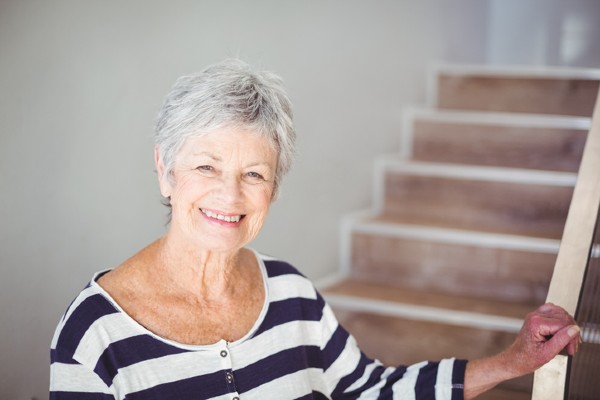Preventing falls is an essential part of caring for seniors. According to the Centers for Disease Control, one in four adults over the age of 65 falls each year, and 3 million people are treated annually in emergency departments for fall-related injuries. Each year, about $50 billion is spent on medical costs of fall injuries.
Seniors and falls don’t have to go together. With the right plan, many senior falls can be prevented at home. Learn about fall prevention for seniors, what to look out for, and the consequences of not implementing fall safety in a home.
What Can Make Seniors Fall?
There can be safety issues in a living space that can put seniors at risk of falling. Some of those will be listed later.
There are also some conditions that may impact falling safety for seniors. Among these are:
- A previous fall. Seniors who have fallen once are likely to fall again.
- Foot pain or numbness, or bad footwear. Foot issues could cause difficulty walking, leading to falls.
- Hypertension. High blood pressure can make someone light-headed, which can cause a fall.
- Lower body weakness or unsteadiness. Canes and walkers help, but seniors must remember to use them.
- New illnesses. Urinary tract infections, dehydration, anemia and other illnesses can be a falling risk factor.
- Sadness or depression. Depression symptoms, such as feeling unwell or slowed down, are linked to falls.
- Use of medicines. Prescription drugs and over-the-counter medications alike can make someone sleepy or unsteady.
- Vision problems. Seniors should have their vision checked to prevent problems with depth perception.
- Vitamin D deficiency. This can cause confusion and weakness, which are risk factors for falling.
These conditions should be addressed by a medical specialist to help improve senior safety.
What Are the Consequences of a Senior Fall?
Seniors who fall can face complications from their fall and going forward. Among these are:
- Emotional injury. Falls can cause significant psychological trauma, which can lead to embarrassment, isolation and other consequences.
- Inactivity. Fear of falling again can cause a senior to become less active, which can cause them to become weaker and increase their chance of falling.
- Loss of independence. According to the National Institutes of Health, seniors often fear becoming dependent on others and having to leave their house after a fall.
- Physical injury. Falls cause broken bones, traumatic brain injury and most commonly soft bumps and bruises.
Seniors who have fallen need more than physical support. They need emotional support to be safe and secure and active again.
What Steps Should Be Taken to Decrease Falling Risks?
Taking a senior fall risk assessment can help determine whether a home or assisted living environment mitigates senior falls. Here are some fall safety tips for seniors:
- Clean up the clutter. Make sure there’s a wide, clear path through each room so that people with wheelchairs and walkers can navigate without issues. Pick up objects on the floor and re-route electrical cords to minimize senior falls and trips.
- Fall-proof the bathroom. Using a rubber mat and shower chairs can help reduce slips and falls in the shower. Adding grab bars or handles can also assist in preventing falls.
- Keep the stairs and other locations well-lit. Senior citizens require adequate light in the home to be able to see properly. Install brighter light bulbs where necessary and add extra light switches to both the top and bottom of the stairs.
- Make kitchen items accessible. Organize your kitchen so that frequently used items are easy-to-reach and obtainable. Avoid using a stool with more than two steps to mitigate the risk of senior falls.
- Update home safety. Put railings on both sides of the stairs. Use two-sided carpet tape to secure rugs to the floor.
Completing a fall risk assessment can help lower the risk of senior falls and make the home a much safer place to be. With careful and diligent preparation, these simple steps can be taken to reduce risks and help keep seniors safe from the danger of falling.
How Improving Health Can Decrease Fall Risk
Improving the physical space a senior lives in can help with decreasing the risks of a fall. But there are more things seniors can do to help themselves.
Exercise
Exercising can be a key factor to keep from falling. Seniors who exercise regularly decrease their fall risk by 23%, according to a recent study.
Exercising also can give you more energy, can improve brain function, and can help prevent and counteract disease.
The Mayo Clinic recommends these activities to help prevent falls:
- Tai chi
- Walking
- Water workouts
- Yoga, including chair yoga
Seniors may also want to consult a physical therapist to get a customized exercise program to improve balance, flexibility, gait and muscle strength.
>> Read 7 Best Exercises for Seniors (and a Few to Avoid!)
Talk to Your Doctor
Don’t be afraid to share your fear of falling. Let them know if you feel unsteady or unsure of your footing. Have them review your medicines, both prescription and over-the-counter medications. Ask about supplements that can help your bone, muscle and nerve health.
The CDC offers a fall risk assessment to check your own risk for falling. Find it here.
Other Factors
Among the other proactive steps you can take to help your own fall safety are:
- Limit alcohol
- Get enough sleep
- Use an assistive device, like a cane or walker
- Stand up slowly, from chairs or a bed
Find Out About Safe Community Living
Learn more about Senior Lifestyle communities today to see how we’re making sure that residents are able to live life to the fullest every day.

